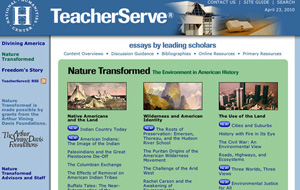talking history | syllabi | students | teachers | puzzle | about us
Nature Transformed: The Environment in American History
http://www.nhc.rtp.nc.us/tserve/nattrans/nattrans.htm
Created and maintained by TeacherServe, National Humanities Center, Research Triangle Park, North Carolina.
Reviewed Nov. 8–30, 2004.
As part of the TeacherServe service offered by the National Humanities Center, Nature Transformed seeks to enrich high school instruction with the most current and advanced scholarship in the field of environmental history. The site designers have called upon leading scholars to author interpretive essays and teaching guides in their respective areas of expertise, for instance, Donald Worster on aridity in the American West, Stephen Pyne on fire landscapes, and Linda Lear on Rachel Carson and the birth of an ecological consciousness. The result is an extensive, although not comprehensive, review of environmental thought and practice from the earliest human settlements in North America to the present day and a rich resource for high school students and teachers.

The interactive Web site is organized around three general themes: “Native Americans,” "Wilderness and American Identity,“ and ”The Use of the Land.“ Additional sections on ”Cities and Suburbs“ and ”The Roots of Preservation“ are scheduled for inclusion in the near future. Within each of these broad categories, scholars explore more focused topics, such as the environmental impact of the Civil War, the idea of ”wilderness," and the disappearance of the buffalo. Short interpretive essays provide an introduction to each topic. Hyperlinked images alongside the text provide access to related primary source documents: photographs, pamphlets, sermons, maps, films, and so forth. Multiple authorship necessarily precludes a uniform interpretation of human transformation of nature, but taken together, the essays dramatize both the ecological disruptiveness of human activity and nature’s enduring capacity to influence human events. Variations in style notwithstanding, the essays do a marvelous job of connecting abstract concepts and remote practices to familiar aspects of daily life. John Stilgoe invites readers to think about the vast impact of road building on American life by considering the role of the yellow school bus in expanding educational opportunities. Shepard Krech suggests that the bison was to the Plains Indian what Wal-Mart is to the modern American consumer. Although the essays are intended for a high school audience, they can be profitably used in a college classroom as well.
Sections on scholarly debates, teaching guidelines, and online resources follow each introductory essay. The scholarly debate sections are most effective when they provide an explicit framework for guiding class discussions. Even when they fail to do so, teachers will undoubtedly appreciate the many innovative suggestions for engaging students with the material. Alfred Crosby, for example, advises teachers to impress students with the far-reaching ramifications of the Columbian exchange through an analysis of their morning’s breakfast. Converting the teaching guidelines into lesson plans will take a bit of work, however. Rarely do the authors provide all the materials necessary to convert their suggestions into full-blown lesson plans.
One of the site’s best features consists of external links to relevant Web sites. These resources, along with each section’s bibliographic references, will be of tremendous assistance to students researching term papers. Due to the site’s emphasis on secondary education, environmental historians will find little here in the way of new scholarship. For nonspecialists looking for an introduction to the field, however, Nature Transformed provides a good overview of the major themes and approaches.
Andrew Hurley
University of Missouri
St. Louis, Missouri
